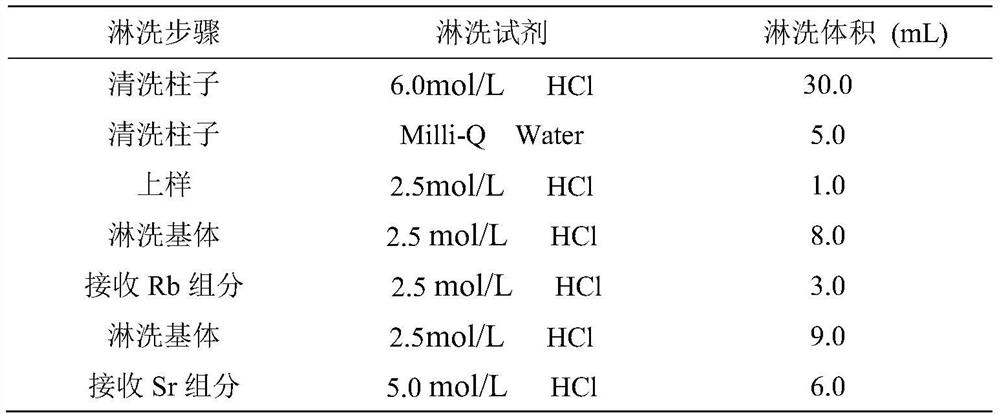A rapid method for detecting rb-sr isotopes in rock samples
A technology for rock samples and isotopes, applied in the field of analytical chemistry, can solve the problems of consuming a lot of time, high analysis cost, and high experimental cost, and achieve the effect of simplifying experimental preparation work, simple operation process, and wide application prospect.
- Summary
- Abstract
- Description
- Claims
- Application Information
AI Technical Summary
Problems solved by technology
Method used
Image
Examples
Embodiment 1
[0089] The present embodiment provides a method for rapidly measuring Rb-Sr content and Sr isotope ratio in a BCR-2 (basalt) sample, which specifically includes the following steps:
[0090] S1. Dissolution and separation and purification of rock samples, as follows:
[0091] S101. Weigh 100±1mg of BCR-2 rock powder, place it in a PFA sample dissolving vessel, add mixed acid (3mL of 22mol / L hydrofluoric acid+0.3mL of 14mol / L nitric acid+0.3mL of 11.8mol / perchloric acid acid) and appropriate 84 Sr- 87 Rb mixed diluent (dilute hydrochloric acid solution medium), closed PFA sample dissolver and digested the sample on an electric heating plate at 160-170°C for 5 days;
[0092] Used in this embodiment and the following embodiments 84 Sr- 87 Rb diluent and isotope dilution method are well known to those skilled in the art, actually adopt by 84 Sr and 87 The mixed solution prepared by Rb diluent in hydrochloric acid medium, the specific dosage varies according to different samp...
Embodiment 2
[0120] The difference between embodiment 2 and embodiment 1 is that this embodiment selects JB-2 basalt standard sample to test the test precision and accuracy of the present invention. Rb, Sr element concentration, 87 Rb / 86 Sr and 87 Sr / 86 Sr detection results are shown in Table 5.
[0121] Table 5. Rb-Sr isotope test results of JB-2 basalt standard sample
[0122]
[0123] Note: The literature value of element concentration is quoted from Geostandard.Geoanalysis.Research.2001,25,87–125; the literature value of Sr isotope ratio is quoted from Geochemical Journal.1998,32,345–350
Embodiment 3
[0125] The difference between embodiment 3 and embodiment 1 is that this embodiment selects JA-3 andesite standard sample to test the test precision and accuracy of the present invention. Rb, Sr element concentration, 87 Rb / 86 Sr and 87 Sr / 86 Sr detection results are shown in Table 6.
[0126] Table 6. Rb-Sr isotope test results of JA-3 andesite standard sample
[0127]
[0128] Note: The literature value of element concentration is quoted from Geostandard.Geoanalysis.Research.2001,25,87–125; the literature value of Sr isotope ratio is quoted from Front.Res.Earth Evol.2003,1,363
PUM
 Login to View More
Login to View More Abstract
Description
Claims
Application Information
 Login to View More
Login to View More - R&D
- Intellectual Property
- Life Sciences
- Materials
- Tech Scout
- Unparalleled Data Quality
- Higher Quality Content
- 60% Fewer Hallucinations
Browse by: Latest US Patents, China's latest patents, Technical Efficacy Thesaurus, Application Domain, Technology Topic, Popular Technical Reports.
© 2025 PatSnap. All rights reserved.Legal|Privacy policy|Modern Slavery Act Transparency Statement|Sitemap|About US| Contact US: help@patsnap.com



